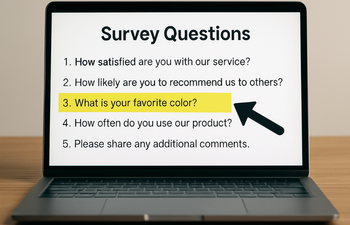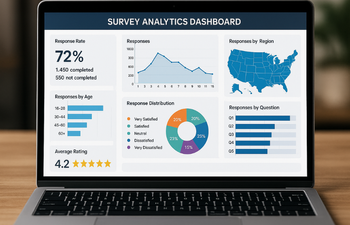How Healthcare Providers Use Patient Surveys to Improve Care
Discover how healthcare providers use patient surveys to improve care, boost satisfaction, and drive meaningful improvements in clinical outcomes.

Introduction
In an increasingly patient-centered healthcare landscape, the importance of understanding patient experiences cannot be overstated. One of the most effective tools in a provider's arsenal is the patient survey.
By capturing patients' voices, healthcare institutions gain vital insights that help shape better clinical practices, optimize operations, and ultimately elevate the quality of care. From small clinics to sprawling hospital networks, the drive toward continuous improvement relies heavily on feedback, making patient surveys more crucial than ever.
For a deeper dive into how survey data can be transformed into actionable strategies, check out From Survey Data to Actionable Insights: A Step-by-Step Guide.
What Are Patient Surveys?
Patient surveys are structured tools used by healthcare organizations to collect feedback directly from those receiving care. These surveys cover aspects like the timeliness of services, the demeanor of medical staff, communication effectiveness, cleanliness of the facility, and overall satisfaction. By systematically analyzing this data, providers can pinpoint strengths and areas needing attention.
Types of Patient Surveys
There’s a wide variety of patient surveys, each tailored to a specific goal or care setting. These include:
- Experience surveys (e.g., HCAHPS)
- Satisfaction surveys
- Outcome surveys
- Post-discharge follow-up surveys
- Digital surveys via mobile apps
Each type plays a different role in enhancing care. For example, outcome surveys focus on the effectiveness of treatments, while satisfaction surveys capture emotional and psychological responses.
To learn more about reducing bias in survey responses, visit Online Survey Psychology: How to Reduce Bias and Get Honest Responses.
How Patient Surveys Help Improve Care
Patient surveys are not just about collecting opinions. When used correctly, they lead to actionable changes. They help:
- Identify gaps in service delivery
- Improve patient-provider communication
- Increase engagement and adherence to treatment
- Enhance workflow efficiency
- Support data-driven decision-making
By turning patient voices into measurable data, providers can implement targeted strategies to enhance service quality.
The Role of Technology in Survey Distribution
Thanks to digital transformation, healthcare providers now deploy surveys through:
- Emails and SMS
- Mobile health apps
- Patient portals
- In-room tablets and kiosks
These methods increase response rates and allow for real-time feedback, enabling quicker response to patient concerns.
Case Study: Leveraging Surveys in a Hospital Network
Take the example of a regional hospital group that implemented a monthly feedback loop via SMS surveys. Within six months, they identified a recurring concern: long waiting times at the outpatient clinic. By reallocating resources and adjusting scheduling systems, they reduced waiting times by 30%, significantly boosting patient satisfaction.
Understanding the HCAHPS Survey
The Hospital Consumer Assessment of Healthcare Providers and Systems (HCAHPS) survey is a standardized national survey in the U.S. that provides a public comparison of hospitals based on patient experiences. It’s a powerful benchmark tool used by CMS (Centers for Medicare & Medicaid Services) to incentivize quality care.
How Surveys Promote Patient-Centered Care
By listening to patient voices, providers foster an environment where care is personalized and respectful of individual preferences. It aligns services with patients’ values and ensures their needs are met compassionately and efficiently.
Improving Clinical Communication Through Feedback
Patients frequently cite poor communication as a source of dissatisfaction. Surveys help uncover these issues. Whether it’s medical jargon or dismissive attitudes, these insights guide training programs that enhance provider empathy and listening skills.
Impact on Staff Behavior and Morale
Interestingly, patient feedback doesn’t just benefit patients. Staff who receive positive mentions in surveys often report higher morale and job satisfaction. Conversely, feedback highlighting behavioral concerns helps initiate necessary coaching or mentorship programs.
Challenges in Patient Survey Implementation
Despite their benefits, patient surveys also come with challenges such as:
- Low response rates
- Survey fatigue
- Language barriers
- Data privacy concerns
Overcoming these requires thoughtful survey design, multilingual options, and secure data handling practices.
Strategies to Increase Survey Participation
To boost participation rates, healthcare providers can:
- Keep surveys short and relevant
- Offer incentives or reminders
- Communicate the value of feedback
- Assure anonymity and confidentiality
These steps help build trust and improve response quality.
Real-Time Analytics for Faster Improvement
With modern survey platforms, feedback doesn’t have to be delayed. Dashboards provide real-time insights, enabling swift decision-making and rapid-cycle quality improvements.
Customizing Surveys for Different Demographics
Different patient groups, seniors, children, or non-native speakers, may require customized questions to ensure the feedback reflects their unique experiences. Inclusive survey design broadens understanding and boosts equity in healthcare delivery.
Integrating Feedback into Quality Improvement Programs
Patient survey data is often embedded into broader quality initiatives, such as Lean Six Sigma or Total Quality Management (TQM). These programs use feedback as a core metric to evaluate success and prioritize projects.
Feedback Loop: From Data to Action
Data without action is meaningless. Healthcare systems must:
- Analyze responses
- Share insights with teams
- Implement changes
- Follow up to measure impact
Creating a visible feedback loop builds accountability and trust among patients and staff alike.
The Importance of Closing the Loop with Patients
It’s vital not just to act on feedback but to communicate those actions back to patients. Whether via newsletters, patient portals, or public dashboards, closing the loop reassures patients their voice matters.
Ethical and Legal Considerations
Survey handling must comply with data protection regulations such as HIPAA in the U.S. and GDPR in Europe. Ethical survey practices also demand transparency about how data will be used.
Trends Shaping the Future of Patient Surveys
The future of patient surveys is being shaped by:
- AI and natural language processing
- Sentiment analysis
- Voice-activated surveys
- Integration with wearable health data
These innovations promise more dynamic, precise, and insightful feedback mechanisms.
Measuring the ROI of Patient Surveys
Healthcare executives increasingly want to quantify the return on investment for survey programs. Metrics might include:
Conclusion
Patient surveys are far more than a feedback mechanism, they are a foundational component of modern healthcare. When administered thoughtfully and acted upon diligently, they create a culture of excellence, transparency, and responsiveness. By embracing patient surveys, healthcare providers don’t just listen, they evolve. And in that evolution lies the promise of better care for everyone.
Frequently Asked Questions
Find answers to the most common questions about this topic
Patient surveys are critical for capturing feedback, identifying service gaps, and making informed improvements in healthcare delivery.
Feedback is gathered through various means, including in-person, online, phone surveys, and mobile applications.
Yes, by acting on feedback, healthcare providers can enhance service delivery, patient satisfaction, and treatment effectiveness.
Most patient surveys ensure anonymity to encourage honest and constructive feedback.
The HCAHPS survey is a standardized tool used in the U.S. to measure patients' perceptions of hospital care and compare hospitals nationally.
They analyze trends, identify root causes, and implement targeted improvement strategies to address issues.









